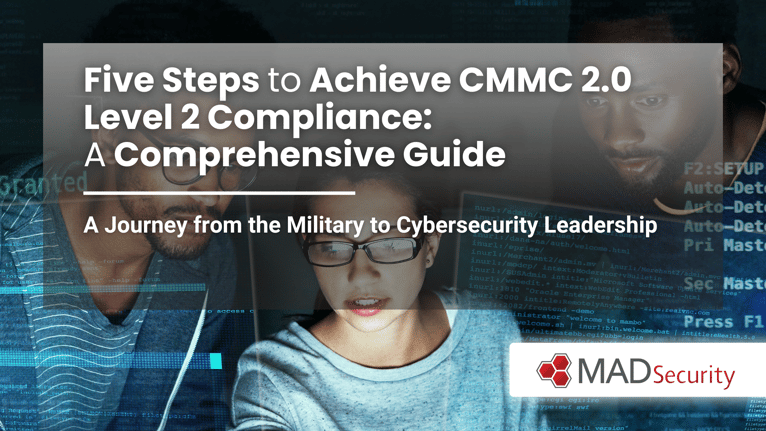
As a Managed Security Service Provider (MSSP) and Registered Provider Organization (RPO) with expertise in CMMC 2.0 compliance, we understand the intricacies involved in navigating the Cybersecurity Maturity Model Certification (CMMC) framework. The journey to becoming CMMC 2.0 Level 2 compliant can seem daunting, but with the right approach and understanding, it is an achievable milestone. This expanded guide provides a detailed roadmap, complete with timelines, to help organizations systematically approach compliance.
Understanding CMMC 2.0 Level 2 Compliance
CMMC 2.0 Level 2 compliance is a mandatory requirement for contractors and subcontractors aspiring to engage in Department of Defense (DoD) contracts. It involves a thorough assessment against all 110 security controls from NIST SP 800-171, ensuring that your organization has documented practices and policies that guide the implementation of cybersecurity efforts effectively.
This level of compliance is crucial not only for securing contracts but also for safeguarding sensitive information and contributing to national security. Organizations must demonstrate their commitment to cybersecurity and their ability to protect Controlled Unclassified Information (CUI).
Steps to Achieve CMMC 2.0 Level 2 Compliance

Understand CMMC Levels
Before embarking on the journey toward compliance, it’s crucial to have a deep understanding of the CMMC framework. CMMC is a tiered model, comprising different levels that reflect an organization’s maturity and reliability in implementing cybersecurity practices. These levels range from basic cyber hygiene at Level 1 to advanced processes at Level 3.
Level 2, often referred to as the “intermediate” level, serves as a transition step for organizations preparing to protect Controlled Unclassified Information (CUI). It requires the implementation of all 110 security practices from NIST SP 800-171. Understanding the nuances of these practices is vital for setting up a robust security infrastructure that can safeguard sensitive government data.
To fully comprehend what each level entails, organizations should invest time in training their staff, attending workshops, and consulting with cybersecurity experts. By doing so, they can accurately determine which level aligns with their objectives and the types of DoD contracts they aspire to acquire. This foundational understanding sets the stage for a focused and informed approach toward achieving and maintaining compliance.

Conduct a Gap Analysis
Conducting a Gap Analysis is a critical step in the compliance journey. It’s a comprehensive assessment that compares your current cybersecurity posture against the stringent requirements of CMMC 2.0 Level 2. This process involves a meticulous evaluation of your existing security infrastructure, policies, procedures, and practices to identify areas that fall short of CMMC standards.
The Gap Analysis should be thorough and honest, highlighting vulnerabilities, inadequate practices, and any instances of non-compliance. It’s not just about checking boxes; it’s about gaining a deep understanding of your cybersecurity landscape and identifying real risks that could compromise sensitive data.
To conduct an effective Gap Analysis, organizations should consider the following:
-
Engage with cybersecurity professionals who have a profound understanding of CMMC requirements.
-
Review documentation, policies, and procedures to ensure they align with CMMC practices.
-
Assess the implementation of security controls in the technical infrastructure.
-
Evaluate the cybersecurity awareness and training of personnel.
-
Identify shortcomings in incident response and recovery plans.
The insights gained from the Gap Analysis will inform the development of a targeted action plan to address deficiencies and bolster your cybersecurity defenses. This plan will lay the groundwork for the subsequent steps in the compliance process.

Develop a System Security Plan (SSP)
The System Security Plan (SSP) is a cornerstone document in the CMMC compliance process. It serves as a blueprint for your organization’s cybersecurity strategy, outlining the security objectives and the measures you will implement to meet CMMC requirements. A comprehensive SSP demonstrates to the DoD that your organization is committed to protecting CUI and has a structured approach to cybersecurity.
Developing an SSP requires a holistic view of your organization’s security posture. It should detail the roles, responsibilities, and resources allocated for maintaining security, as well as the security requirements specific to the CUI you handle. The plan should encompass all aspects of cybersecurity, from physical security and access control to incident response and recovery.
A well-crafted SSP includes:
-
A clear description of the CUI environment, including the systems where CUI is stored, processed, and transmitted.
-
A detailed account of the security requirements and controls implemented to protect CUI.
-
The policies and procedures that guide the implementation and maintenance of security controls.
-
The roles and responsibilities of personnel involved in maintaining cybersecurity.
Creating an SSP is not a one-time task. It requires continuous updates to reflect changes in the cybersecurity landscape, evolving threats, and modifications in your organizational structure or systems. A dynamic SSP ensures that your organization remains vigilant and adaptive in its cybersecurity efforts.

Implement and Assess Information Security Processes
With the SSP as your roadmap, the next step is to implement the necessary security controls and processes. This step translates your plans and policies into tangible actions. It involves deploying security measures, training personnel, establishing procedures, and conducting continuous monitoring to protect CUI.
Implementation should be methodical and aligned with the SSP. It requires coordination across various departments and involves:
-
Installing and configuring security technologies.
-
Conducting regular security awareness training for employees.
-
Establishing incident response protocols.
-
Enforcing access control measures.
-
Regularly updating and patching systems.
Following implementation, a self-assessment is crucial to ensure that the security controls meet the NIST 800-171 standards. This internal review is a rehearsal for the formal assessment and provides an opportunity to identify any overlooked gaps or weaknesses.

Improve Processes and Submit Your Score
Improving processes involves a series of actions, including:
-
Remediating Deficiencies: Address the gaps identified during the self-assessment. This could involve enhancing technical controls, revising policies, or bolstering training programs. Remediation efforts should be prioritized based on the risk associated with each deficiency.
-
Enhancing Cybersecurity Awareness: Human error remains a significant vulnerability. Investing in comprehensive training programs for employees, focusing on cybersecurity best practices and response protocols, is critical.
-
Refining Incident Response: Cybersecurity is not only about prevention but also about response. Review and refine your incident response plan. Conduct simulations and tabletop exercises to ensure that your team can respond effectively to a breach.
-
Implementing Continuous Monitoring: Establish a system of continuous monitoring to detect and respond to threats in real-time. This proactive approach ensures that your defenses are always up to date and that any anomalies are swiftly addressed.
-
Reviewing Vendor Security: In today’s interconnected world, your cybersecurity is only as strong as the weakest link in your supply chain. Ensure that your vendors and third parties adhere to similar cybersecurity standards.
After implementing improvements, it’s essential to measure the impact. Reassess your cybersecurity posture to ensure that the changes have effectively mitigated risks. This iterative process of assess-improve-reassess forms the backbone of a robust cybersecurity program.
Finally, submit your score to the Supplier Performance Risk System (SPRS). This score, derived from your self-assessment, reflects your organization’s readiness to protect CUI and is a requirement for CMMC compliance. Accurate scoring and timely submission are crucial, as they not only demonstrate your commitment to cybersecurity but also influence your eligibility for DoD contracts.
By taking a systematic and thorough approach to improving processes and submitting your score, you fortify your organization’s cybersecurity defenses and take a significant step towards achieving CMMC 2.0 Level 2 compliance.
Timeline for Compliance

Achieving CMMC Level 2 compliance is a comprehensive process that typically takes organizations between 12 to 18 months. This duration accounts for the time needed to thoroughly understand the requirements, conduct gap analyses, develop and implement a System Security Plan (SSP), conduct self-assessments, and make the necessary improvements to cybersecurity processes.
The Department of Defense (DoD) has emphasized the importance of CMMC 2.0 and has expedited its integration into contract requirements. This acceleration means that once the rulemaking process is finalized, CMMC 2.0 will become a mandatory criterion for DoD contracts.
Given this expedited timeline, it’s crucial for organizations aiming to work with the DoD to begin their compliance journey without delay. Starting early affords the necessary time to address any gaps and ensures that your organization is well-prepared when CMMC 2.0 becomes a binding requirement for DoD contracts.
Conclusion
Achieving CMMC 2.0 Level 2 compliance is a rigorous process that demands meticulous planning, a thorough understanding of cybersecurity requirements, and a commitment to continuous improvement. While it presents challenges, it also offers opportunities to fortify your cybersecurity posture, enhance your reputation, and secure your place in the DoD supply chain.
Remember, achieving compliance is not just about meeting regulatory requirements; it’s about fostering a culture of cybersecurity resilience that protects sensitive information and contributes to national security.
For more information on how our services can assist you in achieving CMMC 2.0 Level 2 compliance, please contact us. Together, we can navigate the path to compliance with confidence and precision.
Original Published Date: November 7, 2023
By: MAD Security

